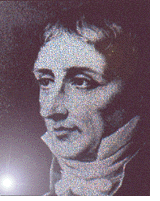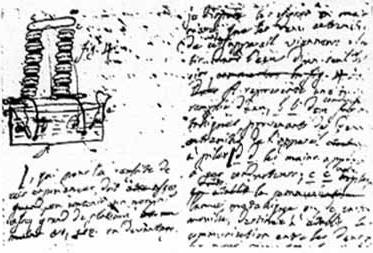Alessandro Guiseppe Antonio Volta
Physicist, b. 18 February 1745 (Como, Lombardy, Italy), d. 5 March 1827 (Como).
 Count Alessandro Volta was from a family of the Italian nobility. The family's fortunes had been on the decline, and Alessandro's siblings all went into service of the church. The young Alessandro developed slowly; he did not talk until he was four years old. His father died when he was seven.
Count Alessandro Volta was from a family of the Italian nobility. The family's fortunes had been on the decline, and Alessandro's siblings all went into service of the church. The young Alessandro developed slowly; he did not talk until he was four years old. His father died when he was seven.
From the age of 14 Volta showed an intense interest in science. He was particularly fascinated by electricity and wrote a Latin poem on the subject. In 1774 he was appointed professor of physics at Como's high school, the Royal School of Como. In the following year he invented the electrophorous, an apparatus to generate static electricity. In 1778 he discovered and isolated methane gas.
Volta's scientific achievements led to his appointment to the chair of physics at the University of Pavia in 1779. More inventions followed, and two years later Volta was elected to membership of the Royal Society.
Volta had frequent correspondence with Luigi Galvani, who had discovered the effect of electricity on muscle contractions in frogs when the muscles were connected to two different metals. Volta was sceptical about Galvani's explanation of the effect through "animal electricity" generated in the brain. In 1794 he decided to see whether a current could be produced without animal tissue solely on the basis of using two different metals.
 Volta's finding that animal tissue was not needed to produce a current began a lengthy controversy between supporters of Galvani's animal electricity and Volta's rejection of that idea. The debate spread through all of Europe.
Volta's finding that animal tissue was not needed to produce a current began a lengthy controversy between supporters of Galvani's animal electricity and Volta's rejection of that idea. The debate spread through all of Europe.
In 1800, two years after Galvani's death, Volta produced the final proof of his concept by constructing the first device that could store electricity through the use of two different metals. In 1801 he was summoned to Paris by Napoleon to demonstrate his invention at the Academy of Sciences.
The invention of the first battery established Volta's fame throughout Europe. Napoleon made him a senator of the kingdom of Lombardy, and after Napoleon's troops were driven out of Italy and Lombardy came under the influence of Austria the Austrian emperor appointed him director of the philosophical faculty at the University of Padua. In 1881 the unit of the electromotive force that drives an electric current was named "volt" in his honour. The energy of moving charged particles is measured in electron-volts.
Among Volta's many inventions the two most important ones were the electrophorous and the Voltaic pile. The electrophorous is the basis of the electrical condensers of today. It consisted of one metal plate covered with ebonite and a second metal plate with an insulated handle. The ebonite-covered plate was rubbed and given a negative electric charge. If the plate with a handle was placed over it, a positive electric charge was attracted to the lower surface, a negative charge repelled to the upper. The upper negative charge built up in the plate with the handle.
The original Voltaic pile was used bowls of salt solution that were connected by means of arcs of metal dipping from one bowl into the next, one end of the arc being copper and the other tin or zinc. Volta soon improved the construction by using small round plates of copper and zinc, plus discs of cardboard moistened in salt solution arranged in the sequence copper, zinc, cardboard. If a wire was attached to the top and bottom of this Voltaic pile an electric current passed through when the circuit was closed. The illustration below shows Volta's sketch and notes for his battery.
Despite his fame Volta remained unselfish. He introduced the term galvanization for the process used to protect iron from rust by coating it with zinc in an electrolytic process.

Reference
Alessandro Volta. Encyclopaedia Britannica 15th ed. (1995)
home
 Count Alessandro Volta was from a family of the Italian nobility. The family's fortunes had been on the decline, and Alessandro's siblings all went into service of the church. The young Alessandro developed slowly; he did not talk until he was four years old. His father died when he was seven.
Count Alessandro Volta was from a family of the Italian nobility. The family's fortunes had been on the decline, and Alessandro's siblings all went into service of the church. The young Alessandro developed slowly; he did not talk until he was four years old. His father died when he was seven. Volta's finding that animal tissue was not needed to produce a current began a lengthy controversy between supporters of Galvani's animal electricity and Volta's rejection of that idea. The debate spread through all of Europe.
Volta's finding that animal tissue was not needed to produce a current began a lengthy controversy between supporters of Galvani's animal electricity and Volta's rejection of that idea. The debate spread through all of Europe.